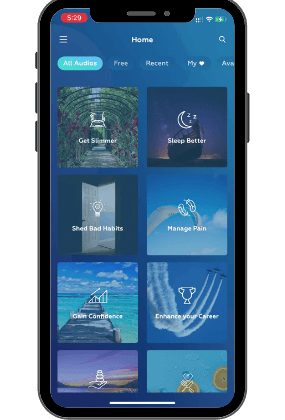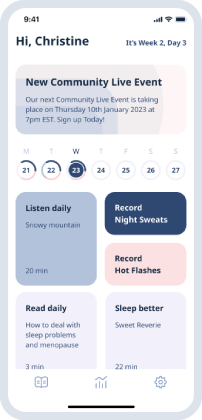
Self-Hypnosis for Menopause Relief: Effective Hot Flashes Management Techniques

The Power of Self-Hypnosis: Menopause How to Help Yourself Through the Transition
Table of Contents
In our fast-paced world, anxiety has become a common and debilitating condition affecting millions worldwide. It’s more than just feeling stressed or worried; it’s a severe health issue that can interfere with daily activities, relationships, and overall quality of life.
Anxiety disorders can emerge from complex risk factors, including genetics, brain chemistry, personality, and life events. Traditional methods for managing anxiety include cognitive-behavioral therapy (CBT), medication, and lifestyle modifications. However, as we seek to address this burgeoning global issue, innovative approaches like self-hypnosis are gaining recognition for their efficacy and accessibility.
Self-hypnosis is a naturally occurring state of mind defined as a heightened state of focused concentration. It’s an age-old technique used for centuries to promote relaxation, reduce stress, and enhance personal development. With the rise of digital technology, this powerful tool is literally at our fingertips. A new wave of self-hypnosis apps has emerged, offering a convenient and cost-effective way to manage anxiety.
These apps, designed by professionals in the field, aim to make self-hypnosis techniques more accessible to those who need them. They offer a promising avenue for individuals seeking to manage their anxiety in the comfort of their homes, on their own terms, and at their own pace. In this article, we will demystify self-hypnosis for anxiety and explore how these innovative apps can help.
Understanding Anxiety
What is Anxiety?
Anxiety is a natural and expected response to stress or perceived danger. It’s characterized by feelings of unease, such as worry or fear, that can be mild or so severe that they interfere with daily life. Everyone experiences anxiety at some point, but when these feelings persist, become overwhelming, or out of proportion to the actual threat, it may indicate an anxiety disorder.
Anxiety Disorders Types
Anxiety disorders include a variety of conditions, each characterized by different symptoms and triggers. Here are some of the most common types of anxiety disorders:
- Generalized Anxiety Disorder (GAD): This disorder is characterized by chronic and excessive worry about everyday events and activities. People with generalized anxiety disorder may find it hard to control their worry and may experience symptoms such as restlessness, fatigue, or difficulty concentrating. As a result, they may not fall asleep quickly.
- Panic Disorder: Individuals with this condition experience recurring panic attacks, i.e., sudden episodes of extreme fear that trigger severe physical reactions when there is no real danger or apparent cause. A panic disorder can be a debilitating condition. Each panic attack comes with physical symptoms such as breathlessness.
- Social Anxiety Disorder: This involves high anxiety, fear, and avoidance of social situations due to embarrassment, self-consciousness, and concern about being judged or viewed negatively by others.
- Phobia-related Disorders: These include specific phobias (intense fear of a particular object or situation), agoraphobia (fear of places or situations that might cause panic, helplessness, or embarrassment), and separation anxiety disorder (fear of being apart from people to whom the individual is attached).
- Post-Traumatic Stress Disorder (PTSD): This mental illness can develop after experiencing or witnessing a traumatic event. Symptoms may include flashbacks, nightmares, severe anxiety, and uncontrollable thoughts about the event.
- Obsessive-Compulsive Disorder (OCD): Characterized by recurrent, unwanted thoughts (obsessions) and/or repetitive behaviors (compulsions). Repetitive behaviors such as hand washing, counting, checking, or cleaning are often performed to prevent obsessive thoughts or make them go away.
These disorders can significantly impact a person’s daily life, but with the right treatment, individuals can manage their symptoms and improve their quality of life.
Causes of Anxiety
The causes of anxiety are multifaceted, often involving a combination of genetic factors, personal circumstances, and life events. Health concerns, financial stress, relationship issues, or significant life changes can trigger it. Symptoms can range from psychological ones, such as excessive worrying, restlessness, and concentration difficulties, to physical ones, like fatigue, muscle tension, and sleep disturbances. The effects of chronic anxiety can be debilitating, influencing every aspect of a person’s life, including their mental, emotional, and physical health.
Traditional Therapies to Overcome Anxiety
Traditional methods for managing anxiety typically involve psychotherapy, medication, lifestyle changes, and various forms of complementary therapies. Cognitive-behavioral therapy, in particular, has been widely used to treat anxiety disorders. Exposure therapy is one of the treatments of choice for phobias. It involves exposing the subject to the fear trigger. Exposure therapy is progressive and, as a result, might take some time. It is often used with CBT to reduce anxiety symptoms.
Medications, such as antidepressants, benzodiazepines, and beta-blockers, are also commonly used. In addition, regular exercise and guided meditations can help release stress and manage anxiety levels. However, these methods might not be suitable or effective for everyone, prompting the need for alternative approaches like self-hypnosis.
The Science of Self-Hypnosis
What is Self-Hypnosis?
Self-hypnosis, also known as auto-hypnosis, is a process that involves inducing a state of hyper-awareness and focus within oneself. Self-hypnosis is also described as a state of focused attention achieved in a relaxed state. During an in-person hypnotherapy session, a hypnotherapist guides you into the same state and adapts the rest of the hypnotherapy session to your needs.
While it shares many similarities with meditation – such as deep relaxation -it’s not akin to meditation because hypnosis benefits from an added component of suggestibility. In essence, it is about harnessing the power of your own mind to usher in positive change.
What Happens During a Self-Hypnosis Session?
The process of self-hypnosis typically involves a few key steps: relaxation, hypnotic induction, concentration, and suggestion phase. The first step consists of achieving deep relaxation, often through breathing exercises or progressive muscle relaxation. Once relaxed, the next step is to concentrate your mind on a specific image or idea. In the suggestion phase, you introduce positive affirmations or statements to your subconscious mind.
Applications of Self-Hypnosis
Hypnotherapy is now mainstream, with many applications showcasing how this mind-body technique can change life. It is versatile, being at times a therapy to overcome depression and anxiety and build healthy habits; at other times, it can help alleviate physical symptoms for conditions. Here are some of its applications:
- Hypnosis for irritable bowel syndrome
- Self-hypnosis for hot flashes and menopause relief
- Stop smoking hypnosis
- Hypnosis to Overcome Depression
The Science of Self-Hypnosis for Anxiety Relief
A growing body of evidence supports the effectiveness of self-hypnosis. Hypnosis works by helping individuals to replace negative thought patterns with positive ones, promoting a sense of calm and control. Research has shown that self-hypnosis can significantly reduce symptoms of anxiety, including those related to specific phobias and panic disorders.
For example, a study measured the impact of a single self-hypnosis session on depression, fatigue, anxiety, and sleepiness. Researchers noticed a significant decrease in sleepiness, anxiety, and depression.
A separate study examines the efficacy of self-hypnosis on patients suffering from increased respiratory rate and other anxiety-inducing symptoms due to chronic obstructive pulmonary disease. A single 15-minute session led to an immediate and significant decrease in anxiety and reduced the respiratory rate.
In the age of digital technology, self-hypnosis has been made even more accessible through mobile apps. These hypnosis apps offer guided sessions, making it easier for individuals to practice self-hypnosis, even beginners.

How Self-Hypnosis Can Help with Anxiety
Self-hypnosis is increasingly recognized as a powerful tool in managing anxiety. It works by helping individuals gain control over their anxiety symptoms, promoting relaxation, and fostering positive changes in thought patterns and behavior.
Multifaceted Approach to Self-Hypnosis Anxiety apps
The role of self-hypnosis in managing anxiety is multifaceted. Firstly, it aids in relaxation. Anxiety often results in physical symptoms such as rapid heart rate, shallow breathing, and muscle tension. Self-hypnosis can help to counter these symptoms by promoting deep relaxation and reducing stress levels.
Secondly, self-hypnosis is a form of self-empowerment. It gives individuals the tools to manage their anxiety independently, which can be particularly beneficial for those who may not have easy access to traditional therapy or medication.
Lastly, self-hypnosis can help change negative thought patterns often accompanying anxiety. Through positive suggestions during the hypnosis process, individuals can learn to replace negative thoughts with positive ones, thereby decreasing the intensity of their anxiety.
Self-Hypnosis Techniques
Several self-hypnosis techniques have proven effective in managing anxiety. Here are a few examples:
- Progressive Muscle Relaxation: This technique involves tensing and relaxing each muscle group in your body, starting from your toes and working your way up to your head. As you focus on the sensation of relaxation, you’ll find your mind becoming quieter and your body more relaxed.
- Breathing Techniques: Deep, slow breathing can help to reduce anxiety and induce a state of relaxation. During self-hypnosis, you can visualize each breath flowing in and out, helping to calm your mind and body.
- Positive Affirmations: These are positive statements you repeat to yourself during self-hypnosis. They work by replacing negative thoughts with positive ones. For example, instead of thinking “I can’t handle this,” you might say to yourself, “I am calm and in control.”
- Visualization: Guided imagery creates a mental image of a peaceful and safe place. It could be an actual location or a site from your imagination. By focusing on this image during self-hypnosis, you can help your mind and body to relax.
In conclusion, self-hypnosis can be a valuable tool in managing anxiety. It is cost-effective, non-invasive, and can be practiced anywhere and anytime.
The Rise of Self-Hypnosis Apps
In the era of digital technology, health, and wellness have found a new avenue. The rise of mobile applications catering to various physical and mental health aspects reflects a broader societal shift towards self-care and well-being. Most people can name a meditation app, and many listen to sleep stories to ease into sleep and stop anxious thoughts.
More apps promise to help you improve your overall health. These apps offer various tools and resources, from fitness tracking and nutrition guidance to mental health support and meditation guides.
Among these burgeoning digital resources catering to different mental health conditions, self-hypnosis apps have carved out a distinctive niche. These apps offer guided self-hypnosis sessions, tips, and techniques to access anytime, anywhere. They bring the power of self-hypnosis into users’ palms, democratizing access to a tool previously reserved for therapy rooms.
Why Are Self-Hypnosis Apps Popular?
But why are these self-hypnosis apps gaining popularity? Several factors contribute to this trend. Firstly, they offer an accessible and affordable alternative to traditional one-on-one therapies. Not everyone has the time, money, or inclination to visit a therapist regularly. In contrast, self-hypnosis apps allow users to manage their anxiety on their own terms.
Secondly, these apps utilize the principles of self-hypnosis in a user-friendly and engaging way. Many apps use audio guides, visual aids, and interactive features to make the process of self-hypnosis more understandable and enjoyable.
Finally, the rise of these apps reflects our growing understanding and acceptance of mental health issues. As conversations around mental health become more mainstream, tools like self-hypnosis apps provide tangible ways for individuals to take control of their mental well-being.
In conclusion, self-hypnosis anxiety apps are riding the wave of mental health apps, providing valuable tools for managing anxiety. As we continue to embrace the potential of technology in enhancing our health and well-being, the popularity of these apps is likely to continue growing.
How Self-Hypnosis Apps Work
Self-hypnosis apps simplify the process of self-hypnosis and make it more accessible to a broader audience. While each app is unique, they generally share some common features and follow similar principles.
Guided Audios to Release Anxious Thoughts
Most self-hypnosis apps work by providing guided audio sessions that lead you through the process of self-hypnosis. These sessions typically start with instructions for achieving a state of deep relaxation with breathing exercises or progressive muscle relaxation techniques. Once you are relaxed, the guide will lead you through visualization exercises or provide positive affirmations to help change negative thought patterns.
In addition to guided sessions, many self-hypnosis apps offer a range of features designed to enhance the user experience. They can allow you to customize your sessions by choosing your own background music or selecting specific affirmations that resonate with you. They may also include mood-tracking features to monitor your progress over time or reminders to help you maintain a regular self-hypnosis practice.
Self-Hypnosis Apps Benefits
The benefits of using an app for self-hypnosis are numerous. Firstly, they provide a convenient way to practice self-hypnosis, allowing you to engage in sessions wherever and whenever suits you. This flexibility can benefit those with busy schedules or limited access to traditional therapy.
Secondly, self-hypnosis apps offer a cost-effective alternative to one-on-one hypnotherapy sessions. When you have limited access to a trained mental health professional, a self-hypnosis app provides you with access to valuable mental health resources. While there may be an initial purchase cost or monthly subscription fee for some apps, this is typically much less than the cost of regular therapy sessions.
Finally, these apps can provide a valuable source of support and motivation. With a self-hypnosis app, you can access guidance and resources at your fingertips, helping you stay committed to your self-hypnosis practice and manage your anxiety effectively.
In summary, self-hypnosis apps utilize technology to make the practice of self-hypnosis more accessible, engaging, and effective. As we continue embracing digital health solutions, these apps will likely play an increasingly important role in helping individuals manage their anxiety.

Who Should Use Anxiety Apps?
Self-hypnosis is safe. But you should consult your mental health therapist if you fall into any of these categories.
- You have a history of schizophrenia or a dissociative disorder.
- You suffer from seizures or other neurological conditions.
- You have post-traumatic stress disorder.
Choosing the Right Self-Hypnosis App for Anxiety
Finding the right self-hypnosis app to manage anxiety can seem overwhelming. Here are some tips and considerations to guide you in your selection.
Firstly, look for an anxiety app that is easy to use with a user-friendly interface. You want to be able to navigate through the app quickly and focus on your self-hypnosis practice without getting frustrated by complicated features or settings.
Next, consider the content of the app. Does it offer guided sessions? Are there different sessions for various issues, such as anxiety, sleep problems, or stress management? The best self-hypnosis apps will provide multiple options to suit your needs.
Also, consider the credibility of the anxiety app. Look for anxiety apps created by professionals in hypnotherapy or mental health with extensive experience treating anxiety. Reviews and ratings can also give you an idea of the app’s effectiveness.
Your Anxiety App is UpNow
One app that ticks all the previous boxes is the UpNow self-hypnosis app for anxiety. It offers a range of guided self-hypnosis sessions designed by professionals using evidence-based techniques to help manage stress effectively.
So why wait? Start your journey towards managing your anxiety with self-hypnosis today. Download the UpNow app and discover the power of self-hypnosis at your fingertips.
UpNow Health only uses high-quality sources, including peer-reviewed articles, to support the facts within our articles. Experts review all our articles to ensure our content is accurate, helpful, and trustworthy.
1. Anlló, H., Herer, B., Delignières, A., Bocahu, Y., Segundo, I., Mach Alingrin, V., Gilbert, M., & Larue, F. (2020). Hypnosis for the Management of Anxiety and Dyspnea in COPD: A Randomized, Sham-Controlled Crossover Trial. International journal of chronic obstructive pulmonary disease, 15, 2609–2620. https://doi.org/10.2147/COPD.S267019
2. Carolyn Daitch (2018) Cognitive Behavioral Therapy, Mindfulness, and Hypnosis as Treatment Methods for Generalized Anxiety Disorder, American Journal of Clinical Hypnosis, 61:1, 57-69, DOI: 10.1080/00029157.2018.1458594
3. D Corydon Hammond (2010) Hypnosis in the treatment of anxiety- and stress-related disorders, Expert Review of Neurotherapeutics, 10:2, 263-273, DOI: 10.1586/ern.09.140
4. Aurélie Untas, Philippe Chauveau, Catherine Dupré-Goudable, Anne Kolko, Fabrice Lakdja & Nicolas Cazenave (2013) The Effects of Hypnosis on Anxiety, Depression, Fatigue, and Sleepiness in People Undergoing Hemodialysis: A Clinical Report, International Journal of Clinical and Experimental Hypnosis, 61:4, 475-483, DOI: 10.1080/00207144.2013.810485













